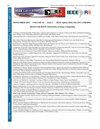光谱相干性作为评估光体积脉搏波中自适应滤波技术的方法
IF 1.3
4区 工程技术
Q3 COMPUTER SCIENCE, INFORMATION SYSTEMS
引用次数: 0
摘要
在这项研究中,我们介绍了一种方法,利用光谱相干性作为一种度量来评估光容积脉搏波(PPG)脉冲信号形态在使用自适应滤波技术过滤肌动力学噪声时的恢复情况。与其他方法不同的是,我们的研究集中在恢复PPG脉冲曲线的大部分组成部分,因为这些揭示了心血管健康状况的非常重要的信息,这对正确的诊断至关重要。为了记录PPG信号,在受试者的双手上放置了一个光电体积脉搏描记系统。一方面,还连接了一个三轴加速度计来捕捉肌动力学运动,而另一方面保持静止,允许PPG系统记录无运动信号。在捕获有运动和无运动的PPG信号后,通过计算自适应滤波后污染信号和恢复信号的频谱相干性进行分析。我们将有噪声的PPG信号与参考信号(无肌动运动的PPG信号)进行比较。基于光谱相干性准则,发现仿射投影算法和变步长仿射投影算法对受肌动力学噪声污染的PPG信号的滤波效果最好,滤波后的信号与无运动脉冲信号的相似度分别为94.25%和94.67%。本文章由计算机程序翻译,如有差异,请以英文原文为准。
Spectral coherence as a method for evaluating adaptive filtering techniques in photoplethysmography
In this study, we introduce a method that utilizes spectral coherence as a metric for assessing the restoration of the photoplethysmographic (PPG) pulse signal morphology when filtering myokinetic noise using adaptive filtering techniques. Unlike other approaches that simply focus on detecting peaks and valleys after filtering, our research concentrates on recovering most of the components of the PPG pulse curve, as these reveal highly important information about cardiovascular health status, and which is essential for a proper diagnosis. To record PPG signals, a photoplethysmography system was placed on both hands of the subjects. On one hand, a three-axis accelerometer was also attached to capture the myokinetic motion, while the other hand remained stationary, allowing the PPG system to record a motion-free signal. After capturing the PPG signals with and without motion, we conducted an analysis by calculating the spectral coherence of the contaminated and recovered signals after adaptive filtering. We compared noisy PPG signals with the reference signal (myokinetic motion-free PPG signal). Based on the spectral coherence criterion, the affine projection algorithm and the variable step-size affine projection algorithm were found to be the most effective for filtering a PPG signal contaminated by myokinetic noise, achieving similarity scores of 94.25% and 94.67%, respectively, between the filtered signal and the motion-free pulse signal.
求助全文
通过发布文献求助,成功后即可免费获取论文全文。
去求助
来源期刊

IEEE Latin America Transactions
COMPUTER SCIENCE, INFORMATION SYSTEMS-ENGINEERING, ELECTRICAL & ELECTRONIC
CiteScore
3.50
自引率
7.70%
发文量
192
审稿时长
3-8 weeks
期刊介绍:
IEEE Latin America Transactions (IEEE LATAM) is an interdisciplinary journal focused on the dissemination of original and quality research papers / review articles in Spanish and Portuguese of emerging topics in three main areas: Computing, Electric Energy and Electronics. Some of the sub-areas of the journal are, but not limited to: Automatic control, communications, instrumentation, artificial intelligence, power and industrial electronics, fault diagnosis and detection, transportation electrification, internet of things, electrical machines, circuits and systems, biomedicine and biomedical / haptic applications, secure communications, robotics, sensors and actuators, computer networks, smart grids, among others.
 求助内容:
求助内容: 应助结果提醒方式:
应助结果提醒方式:


